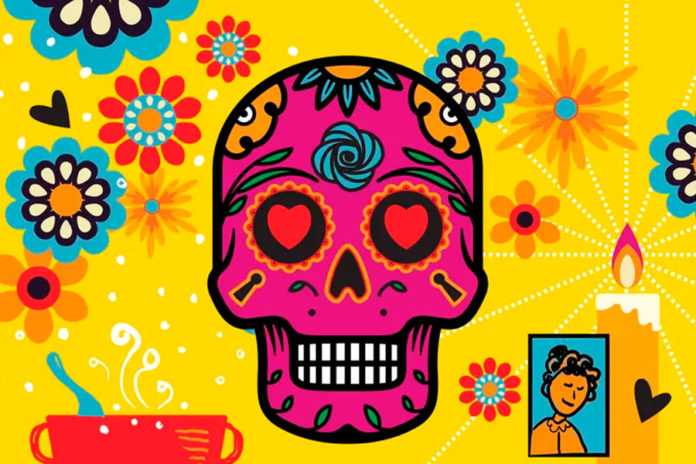
Four Philly Latinos share their traditions that recall and memorialize dead loved ones and ancestors.
The visualization, colors, and liveliness of the Mexican celebration of Día de los Muertos has led many to associate the day with all Latino people. But Latin America is not a monolith, and the mix of Indigenous and white European traditions (especially the Catholic holy day, All Saints’ Day) influences traditions that mark and memorialize dead loved ones and ancestors.
For Latinos in the diaspora, this day can look very different as they connect with their culture from thousands of miles away. While some make their loved ones’ favorite foods, or fly kites in their memory, others force themselves to sit with the absence.
Here, four Philly Latinos explain how they commemorate the Day of the Dead:
Mexico
If you walk by Cherry Street Pier, the Penn Museum, or Iglesias Garden on nov. 2, chances are you’ll see one of artist Cesar Viveros’ altars commemorating how the Mexican community celebrates Día de los Muertos.
Central to Día de los Muertos are the multilevel altars, which represent earth, purgatory, and heaven. Similarly, objects placed on the altar have significance. Cempasúchil flowers (marigold) lead the spirits of loved ones home; papel picado, intricately cut, brightly colored paper, allows souls to travel through the holes; and elegant catrina skulls remind the living to enjoy life.
Viveros’ wife, Ana Guissele Palma, an artist, too, would cut paper silhouettes of her grandparents to decorate the family altar at their home in Kensington, brightening the room with pops of color. She also cooked their favorite foods, enchiladas and mole, as the holiday is believed to be the day of the year where those who passed can feel the living world again. But, in 2018, Palma died.
“Losing her was very difficult,” said Viveros. “Ana had such a strong-willed character, and was always going above and beyond for people.” The first Day of the Dead without her weighed heavily, but the altar became “a way to alleviate the pain.”
Viveros and their children set a table at the entrance of their home with pictures of Ana’s life: cradling her children, creating art with Cesar, being happy. Anything that reminds the family of her essence, including some of her sculptures, are added to the altar. They listen to a song that reminds them of her — this year, Natalia Lafourcade’s song Hasta la Raíz — and eat her favorite food at midnight. “It’s a chance to celebrate her life and give my kids a space to be happy, amongst the sorrow.”
Guatemala
In South Philly, Rosario Marin remembers how her Día de los Muertos looked like before moving to Philadelphia.
Back in Quetzaltenango, three hours away from Guatemala City, Marin’s family would gather around a replica of the Black Christ of Esquipulas, a wooden figure of a crucified Black Jesus worshiped for its purported healing powers. The family would also head outside to make and fly kites, a meaningful tradition that represents “the souls of our loved ones going to heaven,” Marin said. Other family members would make fiambre, a traditional Guatemalan salad of 40 ingredients, including different types of sausages and cheeses, chicken, pacaya flower, corn, pickled onions, beets, and olives and much more.
After church on Nov. 2, the family heads to the local cemetery, fiambre dishes in hand. They will spend the night visiting the tombs of the loved ones who passed, decorating graves with flower crowns, praying the rosary, sharing the fiambre among those present, and leaving an untouched place setting to honor their memory.
The logistics of replicating the cemetery tradition in Philadelphia, and the cost of preparing fiambre, made it hard for Marin to commemorate her loved ones the Guatemalan way. It’s something that pains her more for her children than for herself. “They are from here, but Guatemala is their culture, too,” Marin said.
But with simply glue, tissue paper, and wood strips, Marin keeps the kites flying. Come Nov. 1, the Marin children are off to FDR Park, to see the tributes to the souls of their loved ones fly in Philly’s sky.

Ecuador
Being away from one’s family and culture on dates like this isn’t easy, but for Ecuadorian Silvia Roldan, there is an added layer. According to the Historical Society of Pennsylvania, only 420 Ecuadorians lived in Philly by the early 2000s. And despite the increase in migration, they only make up 1% of the U.S. Hispanic population. So, Roldan struggles to find ingredients and a community that experiences the Día de los Difuntos with the same cultural background.
In Ecuador, the Day of the Dead isn’t a celebration, “it’s a commemoration,” said Roldan. “Nov. 2 carries a deep sense of sorrow. We are more likely to be grief-stricken than to celebrate life.” Even when moments of lightness arise, the occasion is more solemn than its Mexican counterpart.
Instead, Ecuadorian families gather to make their own recipes of colada morada and guagua de pan.
Colada morada is a thick purple drink made out of black or purple corn, with cinnamon, lemongrass, unrefined cane sugar, pineapple skin, the fruit babaco, and strawberries representing sustenance for the trip souls make to the afterlife. The guagua de pan is bread baked in the shape of a guagua, a Kichwa word integrated into Ecuadorian Spanish that means baby, representing the body we leave behind.
After she moved to Philly in 2014 — unable to find the ingredients and having never made the meal by herself — Roldan commemorated her loved ones by keeping their memory in her heart and “thinking of them a little extra” on Nov. 2.
With the birth of her daughter Amaya during the pandemic, Roldan feels like “staying connected with my traditions is the only way she can grow up with her culture.” This year, her mom, Marcia Sarmiento, will be coming from Ecuador to Roldan’s Northwest Philly home to make the meal. “Don’t worry, my child. I will teach you, and you will teach Amaya,” her mom assured.

Argentina
Point Breeze resident Graciela Avendano grew up in the Argentina of the ‘80s, where Día de los Difuntos was observed only as a day to go to church.
Through the decades, Avendano formed friendships with the Mexican community, who showed her their Día de los Muertos celebration, but it never became a tradition her family took on.
That changed on the evening of May 2018. As the rain poured down in the city, her son Pablo Avendano left home on his bike to work as a delivery courier. Three miles away from home, an SUV struck and killed him.
On the first Día de los Difuntos without him, Graciela found solace in the way her Mexican friends celebrated life, setting an altar for Pablo with an Argentinian spin.
Playing Pablo’s favorite music (Rage Against the Machine or Argentinian singer Jorge Cafrune) in the background, Avendano adorns his altar.
“Pablo is always fighting for other people’s rights; he has a revolutionary spirit,” said Avendano, who only speaks of her child in present tense. She places his favorite books, The
Open Veins of Latin America and Free Woman of Spain, on a table in her living room, next to his picture. The altar is finished with peanut M&Ms and a little bear to represent the nickname she gave him as a child, Osito.
Then, she assembles milanesa Argentina, a plate of sliced breaded beef, lettuce, and tomato salad, and french fries, Pablo’s favorite food.
After church, on Nov. 2 the Avendanos will head to Pablo’s memorial, at 10th and Spring Garden, where a ghost bike — a white bike placed in memory of bikers who have been killed or severely injured — rests on a tree. As they share traditional Argentinian mate, family and friends will join them throughout the day to share memories and pay respects — a sign on the tree reads “Pablo Vive.”

Published Oct 27, 2022 Altars, kites and color: How Philly celebrates the Day of the Dead (inquirer.com)




















